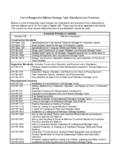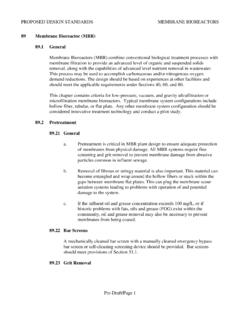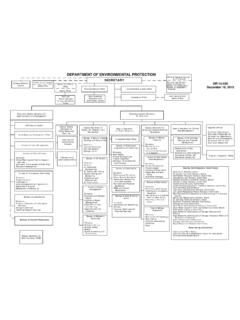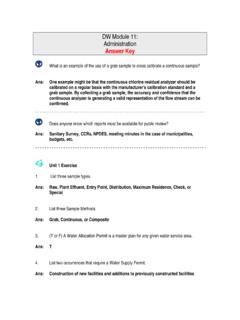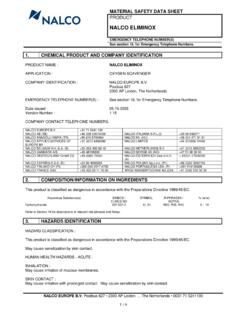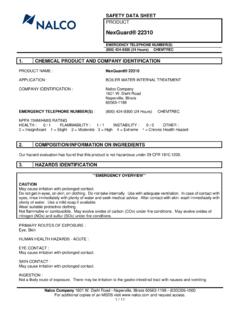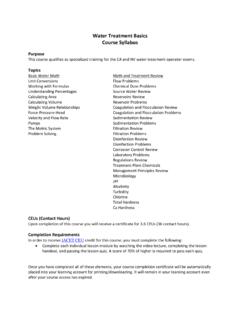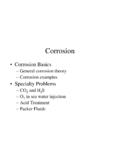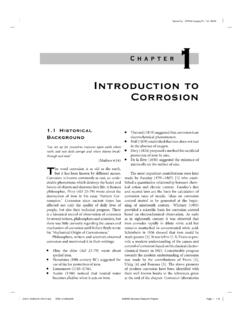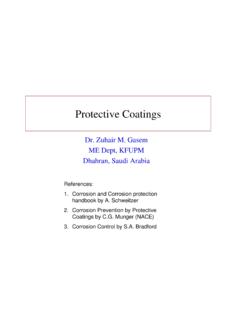Transcription of Module 22: Inorganics Removal Basics - …
1 1 Drinking Water Operator Certification Training Module 22: Inorganics Removal Basics Revised May 4, 2018 This course Module was developed by the Pennsylvania Department of Environmental Protection. Content sources are referenced at the end of every Module unit. 2 3 DISCLAIMER: This Module was designed as a training Module for Pennsylvania drinking water operators to study prior to taking the drinking water subclass 9 ion exchange and greensand exam. The focus of this exam is the Removal of inorganic constituents from drinking water using the treatment processes ion exchange or greensand filtration.
2 As a result, this training Module focuses on the treatment methods of ion exchange units and greensand filters. In addition, there is a focus on the Removal of some of the inorganic contaminants common in Pennsylvania groundwater systems: nitrates, iron, and manganese. Since arsenic, barium and mercury, may sporadically be found in Pa. groundwater, treatment options for these contaminants will also be mentioned in this Module . Because radionuclides, radon, and hydrogen sulfide may also be found in Pa groundwaters, they are also briefly mentioned.
3 Water softening is also discussed. Note that since lead and copper treatment is covered in Module 20: corrosion control and Sequestering, treatment of those inorganic contaminants is not discussed in this Module . The 2006 version of the Pa. DEP inorganic Contaminant Removal Module has detailed advanced treatment information on this topic and can be obtained by e-mailing the Pa. DEP Safe Drinking Water Training Section at to request a copy. This advanced Module has additional information on the Removal of various inorganic contaminants as well as on oxidation, ion exchange, activated alumina and sequestration.
4 The 2006 document also includes more detailed information on the inorganic contaminant treatments of GAC (granular activated carbon), coagulation/filtration, membranes, and lime softening. It includes the following information: inorganic contaminant treatment selection considerations Advanced inorganic contaminant Removal chemistry terminology Advanced inorganic contaminant Removal chemistry explanations Conventional filtration and how it relates to inorganic Removal Detailed information on treatments for iron and manganese Removal Detailed information on treatments for hardness Removal Detailed information on inorganic contaminant monitoring protocols Detailed tables on the following topics.
5 O Sources of 26 inorganic contaminants o Common secondary standards with effects, inorganic contributors and indications o Various treatment technology options to consider for 24 inorganic contaminants o Potential forms of iron and manganese o Iron and manganese sampling procedures o Iron and manganese oxidant selection criteria o Iron and manganese theoretical (initial) dosing criteria o Potential treatments for less common Inorganics o Potential treatments for miscellaneous trace metals 4 Unit 1: inorganic Contaminant Basics I.
6 Basic inorganic Definitions II. Primary inorganic Contaminants III. Secondary Contaminants Unit 2 - Basic Math Review I. Complex Multiplication and Division II. Algebra Problems III. Unit conversions IV. Filter Surface Area V. Filter Volume Unit 3 inorganic Removal Chemistry I. Basic inorganic Removal Chemistry II. inorganic Removal Chemicals III. pH and Water Temperature Unit 4 inorganic Treatments I. Treatment Definitions II. Treatment Considerations III. Treatment Methods A. Sequestration B. Ion Exchange C.
7 Oxidizing Filters D. Other Methods IV. Treatment Consideration Example Unit 5 - inorganic Filter Calculations I. Filter Loading Rate Calculations II. Filter Media Volume Calculations III. Ion Exchange Brine Calculation Unit 6 inorganic Treatment Maintenance I. Ion Exchange Unit Maintenance II. Media Filter Maintenance 5 Appendices Appendix A: Pennsylvania Safe Drinking Water Maximum Contaminant Level (MCL) & Maximum Residual Disinfectant Levels (MRDLs) List (Draft 10-2017) Appendix B: Sources of inorganic Contaminants Appendix C: Treatment Technology Options Appendix D: Radionuclide Treatment Technologies Appendix E: inorganic Removal Pre-Test (Note: The information in Appendices A, B, C, & D is important inorganic contaminant reference material.)
8 However, the information in these 4 Appendices is not on the exam.) 6 7 Unit 1 inorganic Contaminant Basics Learning Objectives At the end of this unit, you should be able to: Explain how a primary and a secondary inorganic contaminant are different. State a few primary inorganic contaminant concerns State a few secondary inorganic contaminant concerns Be able to reference the MCL list inorganic Removal Pre-Test There is a 10 question pre-test at the end of the workbook in Appendix E.
9 Please complete this pre-test now and then return to the lesson. The pre-test will help solidify a few introductory course concepts as well as review a few basic math concepts. I. inorganic Contaminant Definitions Let s start by defining a few inorganic terms. Inorganics are mineral-based compounds such as metals, nitrates, and asbestos that do not contain organic materials. Maximum Contaminant Level (MCL) The maximum permissible level of a contaminant in water which is delivered to a user of a public water system.
10 Primary Contaminant - A compound which is regulated in drinking water because of the potential to cause a health effect. 8 Secondary Contaminant A compound which is generally not considered to cause a health effect but can cause aesthetic issues ( taste, odor, color of water, etc.) As a result, this contaminant is monitored in drinking water and a maximum contaminant level has been established. The word secondary indicates it is not a contaminant that generally causes an adverse health effect. II. Primary inorganic Contaminants As stated in the definitions above, inorganic contaminants of concern in drinking water are separated into primary and secondary contaminants.

